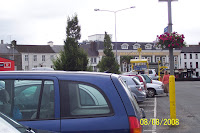WHEN WE DROVE FROM THE IRISH Republic back into the United Kingdom, there was no fanfare, and in fact the transition from one country to another seemed to be completely unmarked (possibly because it was straddled by road works), apart from the change from kph to mph—which may have caused a problem till Don suddenly realised he was driving at 30 mph, thinking that the
50 sign still meant kph.

It was much the same when we drove back down into The Republic today, and probably for the same reason—But pause! Rewind! We drove back down into The Republic today? What was
that about?
It was about the fact that we’d intended to visit Newgrange on the way out of The Republic, but had been waylaid by Tara instead (having stumbled across it first). No regrets about Tara—everyone should visit!—but Newgrange remained very high on our lists of “must sees”, so—why not?
We made breakfast in our kitchen, from the supplies we’d bought at Tescos, then went down to the basement and took the car up onto the Lisburn Rd and down to the M1. About 100 minutes later (around 11 a.m.), we pulled up in the Newgrange car park.
People (including kiwis back home) say to us, “You’re from New Zealand? That’s such a beautiful country! What the heck are you over in the UK for?” Well, of course, the Republic isn’t part of the UK, but the same answer does for both: the British Isles are beautiful too,
and they have something NZ lacks: ancient (pre)history!
(But they’re not really “home” …)
Ancient (pre)history! You might think from our travels so far we’d had enough of it, but not us! Newgrange is one of the places that ancient (pre)history buffs just
have to visit if they get the opportunity just once in their lives! (Not to mention sprinkling exclamation marks around like crazy! But when you ain’t got much to say, say it with
vigour, yassuh!)
And ancient (pre)prehistory buffs don’t come much more ancient (or buffy) than us … …
Ahem. After a bit of a quiet lie-down, Our Author continues …
You can’t get to the site except via the
Visitor Centre, and when we got there we found you have to be organised into tours. Newgrange is part of a wide sacred landscape (the
Brú na Bóinne complex), and initially we booked into a tour that would also take us out to
Knowth (an associated site, about a mile away, apparently as spectacular as Newgrange, but in different ways). But a wee bit of questioning showed that if we took just the Newgrange tour, we might be able to satisfy one of Margaret’s ambitions, too, visiting the Lisburn Linen Museum on the way back (since the Nottingham Lace Museum which we’d hoped to visit on an earlier occasion had closed down); so we booked onto the 1:45 tour of Newgrange only.

If you have to visit a Visitor Centre, we’d thoroughly recommend the one at Newgrange. The initial exhibits are a series of brilliant models showing the landscape around Newgrange, both as it is, and at various periods during its development from around 3,300 BC, until it disappeared from view as a human structure around 2,000 BC; then you come to dioramas and reconstructions of Neolithic living.
So what is Newgrange? It’s a prehistoric chambered mound representing a tomb and religious centre with astronomical implications. It’s BIG (a rough circle 250 feet across and 40 feet high), and it’s OLD—older than the oldest Egyptian pyramid, and older than the stone circles at Stonehenge. And it’s ASTRONOMICAL: once a year, at the time of the winter solstice, the sun shines directly along the long interior passage into the central chamber for about 17 minutes as it rises, and illuminates the chamber floor for a very short time.

It’s also visually spectacular, but we’ll come to that shortly. We toured the Visitor Centre, bought the inevitable couple of guidebooks, and lunched in the café, and then it was time for our group to make their way to the bus stop. This took us across a footbridge over the flooded River Boyne, reminding us of the floods we’d missed just two days before. “Brú na Bóinne” means, “The Palace of the Boyne”; the river is supposedly named after the local river goddess Boaná, “She of the White Cow”; she was the mother of Young Angus,
Aengus Óg, god of love and lovers, of poetry, and of the dawn. Newgrange was the home of the gods, the
Tuatha dé Danaan (“Too-aha jay Duhnairn”, very roughly), and of Aengus Óg’s father, “the
Dagda”.

Our first, exciting, view of Newgrange was from the bus. Seen over the top of the hedge that borders the lane, its white quartz façade gleamed against the lowering clouds. The façade is controversial: after the mound had gone out of use, its sides collapsed outwards until it looked like just another hill; its nature was only rediscovered during Michael O’Kelly’s excavations starting in 1962. As well as excavating, O’Kelly did much restoration, as part of which, the white quartzite and dark granite stones that were
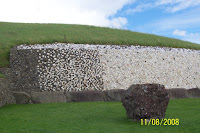
found buried in the slippage at the front of the mound were placed into a near vertical steel reinforced concrete wall. Critics say that the technology to achieve anything like this didn’t exist until modern times; a similar mound at Knowth has been reconstructed with the stones laid out to form a sort of “apron” before the entrance. But the sight of the arrangement at Newgrange, the white quartzite at the front shading round through the grey granite at the sides, is surely spectacular!

You can also see, on the last photo and on this, some of th

e “kerbstones” that line the perimeter of the mound. There are almost a hundred of them, most recumbent but some upright; many are decorated with megalithic art (incised rings, spirals, wavy lines, and lozenges), though Knowth is apparently much more magnificent in that respect. But the entrance to the passage that runs into the mound is guarded by a wonderful stone, reckoned as “one of the most famous stones in the entire repertory of megalithic art”, which may represent the sacred landscape itself, with the waves of the river at the base. (Well, that’s one of several interpretations.)
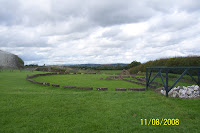
There are several ruinous prehistoric monuments around the mound (which is the only one that’s been restored), and there was time to wander round them while keeping one ear open for the guide’s explanation of the site. But the climax of the visit always
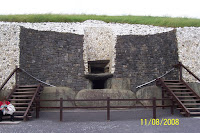
takes place inside the mound. You have to climb up and down some steps that lead over the fronting stones, then duck your head (unless you’re vertically challenged) to enter the doorway. Inside, the 19-metre (20-yard) stone-lined passage follows a slightly wavy path up a slight incline, to the central chamber, the floor of which lies a fraction above the level of the top of the entrance doorway to the mound.
The central chamber has a magnificent corbelled (overlapped stone) roof, six metres high (20ft), which, the guide assured us, “has never leaked in 5,000 years.” (This is almost certainly true!) There are three semi-circular recesses off the central chamber, making a sort of cross shape, quite common in these prehistoric mounds both in Britain and Ireland, and in Europe. The guide talked us through all this, but the magical part came at the end, when she switched out the lights. We all stood in an expectant, and slightly awed, silence, until, after a few seconds, a golden glow crept up the floor of the passage, and fell on the chamber floor at our feet. It lasted for a

breathless a quarter of an hour, before fading gradually away.
This was a simulation of the phenomenon that occurs each year at sunrise on December 21st, the Winter Solstice. After an interval of a couple of thousand years, Michael O’Kelly was the first person in modern times (1967) to see it. There are other megalithic sites that show a similar phenomenon, but only here does the light enter through a specially-constructed “light box” above the entranceway, and only here does it exactly graze the walls of the sinuous passage leading to the chamber. Photography within the mound is, of course, forbidden …
There’s never time enough, particularly with a site so rich as Newgrange, and all too soon we had to get back on the bus and return to the Visitor Centre. We took a last look round the shop (an excellent
magneto of the front kerbstone, but no bookmarks or cross-stitch), walked back to the car, and headed north in hopes of getting to the Lisburn Linen Museum.
It was pretty hopeless, really, thanks to heavy traffic and constant road works: we got to Lisburn just as the museum and its shop were closing (5 p.m.); quite a disappointment, on our last day in Ireland (going home tomorrow). But as a consolation prize, we went back to the
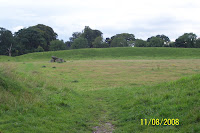
apartments via the
Lagan Valley Regional Park, “a mosaic of countryside, urban parks, heritage sites, nature reserves and riverside trails”, though we had time for only one of its features: the
Giant’s Ring, one of the finest
raths or henges (circular earthwork enclosures) in the British Isles, dating from around 4,700 years ago. More than 200 metres across, with a bank now reduced to “only” four metres high (that’s 13 ft), it lies about five miles from Lisburn and four from central Belfast.
In the centre is a dolmen, the remains of an ancient earth-covered tomb, with the earth long-since gone. If you can do the “cross-your-eyes” trick, the two photos here, showing the dolmen and the bank beyond it, make a stereoscopic double.


During the 18th century, the
Giant’s Ring was used for horse-races and ploughing competitions, but it was rescued in 1847 by the local land owner, who put up a wall round it. A stone let into the wall reads:

THIS WALL FOR THE PROTECTION OF
THE GIANT'S RING
WAS ERECTED A.D. MDCCCXLI BY
ARTHUR VISCOUNT DUNGANNON
[On whose] estate this singular relique of
[the ancients] is situated and who earnestly
recommends it to the care of his successors.
Thankyou, Lord Dungannon …
















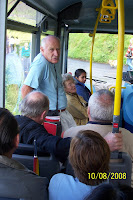

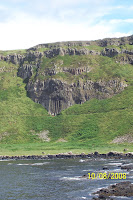



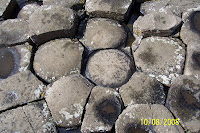
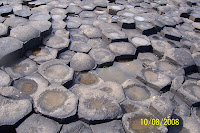


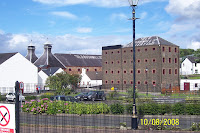
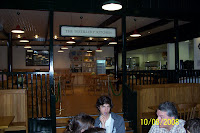



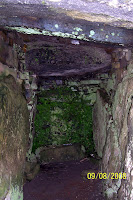


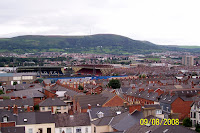





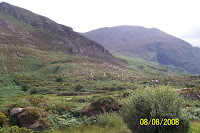
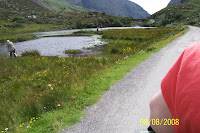






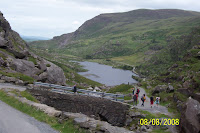






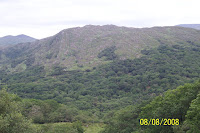

 We parked again off College St, our usual location, and went shopping down College and Plunkett
We parked again off College St, our usual location, and went shopping down College and Plunkett 